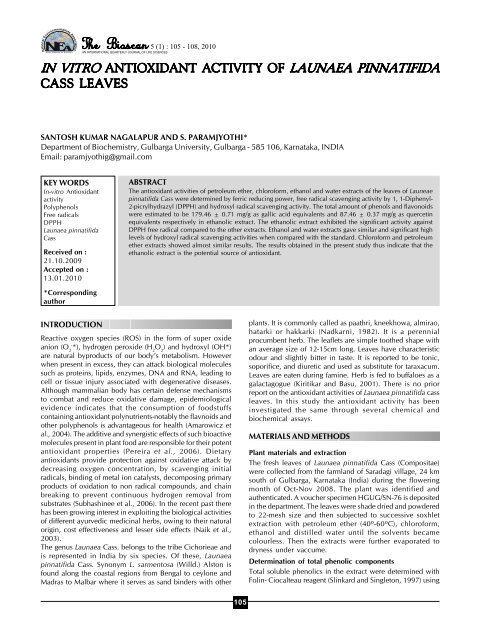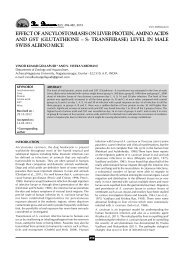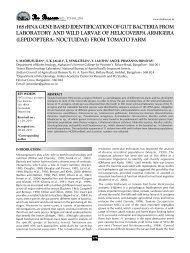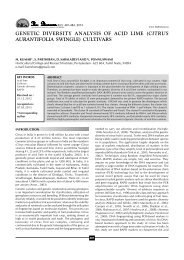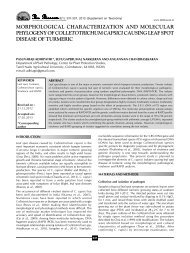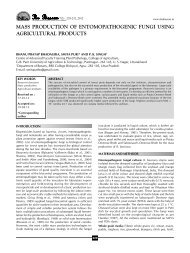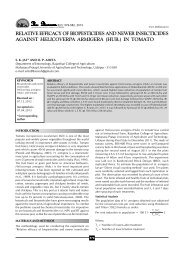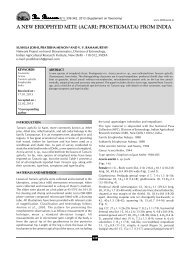SANTOSH KUMAR NAGALAPUR.pmd - THE BIOSCAN
SANTOSH KUMAR NAGALAPUR.pmd - THE BIOSCAN
SANTOSH KUMAR NAGALAPUR.pmd - THE BIOSCAN
- TAGS
- santosh
- kumar
- bioscan
- thebioscan.in
Create successful ePaper yourself
Turn your PDF publications into a flip-book with our unique Google optimized e-Paper software.
NSave Nature to Survive<br />
5 (1) : 105 - 108, 2010<br />
IN IN VITRO VITRO ANTIO ANTIOXID ANTIO ANTIO XID XIDANT XIDANT<br />
ANT A AACTIVITY<br />
A CTIVITY OF OF LA LAUNAEA LA UNAEA PINNA PINNATIFID<br />
PINNA TIFID TIFIDA TIFID<br />
CASS ASS LEA LEAVES LEA VES<br />
<strong>SANTOSH</strong> <strong>KUMAR</strong> <strong>NAGALAPUR</strong> AND S. PARAMJYOTHI*<br />
Department of Biochemistry, Gulbarga University, Gulbarga - 585 106, Karnataka, INDIA<br />
Email: paramjyothig@gmail.com<br />
KEY WORDS<br />
In-vitro Antioxidant<br />
activity<br />
Polyphenols<br />
Free radicals<br />
DPPH<br />
Launaea pinnatifida<br />
Cass<br />
Received on :<br />
21.10.2009<br />
Accepted on :<br />
13.01.2010<br />
*Corresponding<br />
author<br />
INTRODUCTION<br />
ABSTRACT<br />
The antioxidant activities of petroleum ether, chloroform, ethanol and water extracts of the leaves of Launeae<br />
pinnatifida Cass were determined by ferric reducing power, free radical scavenging activity by 1, 1-Diphenyl-<br />
2-picrylhydrazyl (DPPH) and hydroxyl radical scavenging activity. The total amount of phenols and flavonoids<br />
were estimated to be 179.46 ± 0.71 mg/g as gallic acid equivalents and 87.46 ± 0.37 mg/g as quercetin<br />
equivalents respectively in ethanolic extract. The ethanolic extract exhibited the significant activity against<br />
DPPH free radical compared to the other extracts. Ethanol and water extracts gave similar and significant high<br />
levels of hydroxyl radical scavenging activities when compared with the standard. Chloroform and petroleum<br />
ether extracts showed almost similar results. The results obtained in the present study thus indicate that the<br />
ethanolic extract is the potential source of antioxidant.<br />
Reactive oxygen species (ROS) in the form of super oxide<br />
- anion (O *), hydrogen peroxide (H2O ) and hydroxyl (OH*)<br />
2<br />
2<br />
are natural byproducts of our body’s metabolism. However<br />
when present in excess, they can attack biological molecules<br />
such as proteins, lipids, enzymes, DNA and RNA, leading to<br />
cell or tissue injury associated with degenerative diseases.<br />
Although mammalian body has certain defense mechanisms<br />
to combat and reduce oxidative damage, epidemiological<br />
evidence indicates that the consumption of foodstuffs<br />
containing antioxidant polynutrients-notably the flavnoids and<br />
other polyphenols is advantageous for health (Amarowicz et<br />
al., 2004). The additive and synergistic effects of such bioactive<br />
molecules present in plant food are responsible for their potent<br />
antioxidant properties (Pereira et al., 2006). Dietary<br />
antioxidants provide protection against oxidative attack by<br />
decreasing oxygen concentration, by scavenging initial<br />
radicals, binding of metal ion catalysts, decomposing primary<br />
products of oxidation to non radical compounds, and chain<br />
breaking to prevent continuous hydrogen removal from<br />
substrates (Subhashinee et al., 2006). In the recent past there<br />
has been growing interest in exploiting the biological activities<br />
of different ayurvedic medicinal herbs, owing to their natural<br />
origin, cost effectiveness and lesser side effects (Naik et al.,<br />
2003).<br />
The genus Launaea Cass. belongs to the tribe Cichorieae and<br />
is represented in India by six species. Of these, Launaea<br />
pinnatifida Cass. Synonym L. sarmentosa (Willd.) Alston is<br />
found along the coastal regions from Bengal to ceylone and<br />
Madras to Malbar where it serves as sand binders with other<br />
105<br />
plants. It is commonly called as paathri, kneekhowa, almirao,<br />
hatarki or hakkarki (Nadkarni, 1982). It is a perennial<br />
procumbent herb. The leaflets are simple toothed shape with<br />
an average size of 12-15cm long. Leaves have characteristic<br />
odour and slightly bitter in taste. It is reported to be tonic,<br />
soporifice, and diuretic and used as substitute for taraxacum.<br />
Leaves are eaten during famine. Herb is fed to buffaloes as a<br />
galactagogue (Kiritikar and Basu, 2001). There is no prior<br />
report on the antioxidant activities of Launaea pinnatifida cass<br />
leaves. In this study the antioxidant activity has been<br />
investigated the same through several chemical and<br />
biochemical assays.<br />
MATERIALS AND METHODS<br />
Plant materials and extraction<br />
The fresh leaves of Launaea pinnatifida Cass (Compositae)<br />
were collected from the farmland of Saradagi village, 24 km<br />
south of Gulbarga, Karnataka (India) during the flowering<br />
month of Oct-Nov 2008. The plant was identified and<br />
authenticated. A voucher specimen HGUG/SN-76 is deposited<br />
in the department. The leaves were shade dried and powdered<br />
to 22-mesh size and then subjected to successive soxhlet<br />
extraction with petroleum ether (40º-60ºC), chloroform,<br />
ethanol and distilled water until the solvents became<br />
colourless. Then the extracts were further evaporated to<br />
dryness under vaccume.<br />
Determination of total phenolic components<br />
Total soluble phenolics in the extract were determined with<br />
Folin- Ciocalteau reagent (Slinkard and Singleton, 1997) using
<strong>SANTOSH</strong> <strong>KUMAR</strong> <strong>NAGALAPUR</strong> AND S. PARAMJYOTI<br />
gallic acid as the standard phenolic compound.<br />
1 mL of extract solution containing 1g extract in the volumetric<br />
flask was diluted with 46 ml of distilled water. 1mL of Folin-<br />
Ciocalteau reagent was added and the content of flask was<br />
mixed thoroughly. 3 minutes later 3 mL of 2% saturated sodium<br />
carbonate was added to the mixture and was allowed to stand<br />
for 2 hr with intermittent shaking. The absorbance of the blue<br />
color developed was read at 760 nm. The concentration of<br />
the total phenols was expressed as mg/g of dry extract (Kim et<br />
al., 2003). The concentration of total phenolic compounds in<br />
the extract was determined as µg of gallic acid equivalent<br />
using an equation obtained from the standard gallic acid curve.<br />
Absorbance = 0.0008 × gallic acid (µg).<br />
Determination of total flavanoids<br />
1mg samples were added to 1mL of 80% ethanol. Aliquot of<br />
0.5mL was added to the test tubes containing 0.1 mL of 10%<br />
aluminum nitrate, 0.1 mL of 1 M potassium acetate, and 4.3<br />
mL of 80% ethanol. The absorbance of the supernatant was<br />
measured at 415 nm after 40 minutes of incubation at room<br />
temperature. Total flavonoid concentration was calculated<br />
using quercetin as standard (Nieva Moreno et al., 2000).<br />
Absorbance = 0.002180 × µg quercetin – 0.01089.<br />
Ferric reducing activity<br />
Different concentrations of extracts (20µg, 100µg and 200µg)<br />
were mixed with 2.5 mL of 200 mmol/L sodium phosphate<br />
buffer (pH 6.6) and 2.5 mL of 1% potassium ferricyanide. The<br />
mixture was incubated at 50ºC for 20 minutes then 2.5 mL of<br />
10% trichloroacetic acid (w/v) was added, the mixture was<br />
centrifuged at 1000 rpm for 8 minutes, the upper layer was<br />
mixed with 5 mL of deionised water and 1 mL of 0.1% of ferric<br />
chloride, and the absorbance was measured<br />
spectophotometrically at 700 nm. (Barros et al., 2007). Higher<br />
absorbance of the reaction mixture indicated greater reducing<br />
power.<br />
DPPH radical scavenging activity<br />
Different concentrations of leaf extracts and Butylated hydroxyl<br />
anisole (BHA) (20µg, 100µg and 200µg) were taken and the<br />
volume was adjusted to 100µL by adding methanol. 5 mL of<br />
0.1 mM methanolic solution of 1, 2-Diphenyl picryl hydrazine<br />
(DPPH) was added. The mixture was shaken vigorously and<br />
allowed to stand for 30 minutes in dark. 0.01 mM solution of<br />
DPPH in methanol was used as control, whereas BHA was<br />
used as a standard. The reduction of DPPH radical was<br />
determined by measuring the absorption at 517 nm (Barros et<br />
al., 2007). The radical scavenging activity (RSA) was calculated<br />
as a percentage of DPPH discoloration using the equation:<br />
(Absorbance of control - Absorbance of<br />
sample)<br />
% RSA= X 100.<br />
(Absorbance of control)<br />
IC value for the extract i.e. the concentration at which it<br />
50<br />
scavenges 50 % of DPPH radical was calculated.<br />
Hydroxyl radical scavenging activity<br />
Different concentrations of leaf extracts and BHA (20 µg, 100µg<br />
and 200µg) were taken and the volume was adjusted to 250µL<br />
with 0.1 M phosphate buffer (pH 7.4). 1 mL of iron - EDTA<br />
solution (0.13% ferrous ammonium sulfate and 0.26% EDTA),<br />
106<br />
0.5 mL of EDTA (0.018%), and 1 mL of dimethyl sulphoxide<br />
(0.85% v/v in 0.1 M phosphate buffer, pH 7.4) were added to<br />
these solutions. The reaction was initiated by adding 0.5 mL<br />
of 0.22% ascorbic acid. The reaction mixtures were incubated<br />
at room temperature for 30 minutes. The reaction was<br />
terminated by the addition of 1mL of ice-cold TCA (17.5% w/<br />
v). 3mL of Nash reagent was added and the reaction mixture<br />
was allowed to stand at room temperature for 15 minutes for<br />
colour development. The intensity of the yellow colour formed<br />
was measured spectrophotometrically at 412 nm against the<br />
reagent blank (Singh et al., 2002). The percentage of hydroxyl<br />
radical scavenging activity (HRSA) was calculated by using<br />
following equation:<br />
% HRSA=<br />
1- (Absorbance of sample)<br />
(Absorbance of Blank)<br />
X 100.<br />
IC value of the extract was calculated as mentioned earlier.<br />
50<br />
Statistics<br />
The experiments were done in triplicate. Data are expressed<br />
as mean ± SEM. One- way analysis of variance (ANOVA) was<br />
used and the Dunnet’s test was used for comparison of mean<br />
values. All tests were considered to be statistically significant<br />
at p
Table 1: Total phenolic and flavonoid content of various extracts of<br />
Launaea pinnatifida Cass<br />
Extracts Total phenols Total flavonoids<br />
(mg/g) ± SEM (mg/g) ± SEM<br />
PE 45.36±0.80 7.78±0.28<br />
CE 62.36±0.45 19.69±0.26<br />
EE 179.46±0.71 87.46±0.37<br />
WE 172.66±0.56 71.54±0.30<br />
PE- Pet ether extract, CE- chloroform extract, EE- ethanolic extract; WE- water extract; Total<br />
phenols are expressed as gallic acid equivalent/g; Total flavonoids are expressed as<br />
quercetin equivalent/g; SEM= Standard Error Mean<br />
Absorbance at 700 nm<br />
Concentration (µg)<br />
Figure 1: Ferric reducing activity of Launaea pinnatifida Cass leaves<br />
WE-Water extract, CE- Chloroform extract, EE- Ethanolic extract, PE- Petroleum ether<br />
extract, BHA- Butylated hydroxyl anisole<br />
appraise the antioxidant activity of various natural products<br />
(Hu and Kitts, 2000). In the presence of compounds capable<br />
of donating a hydrogen atom or an electron, its free radical<br />
nature is lost; hence a decrease in absorption at 517 nm is<br />
seen. Figure illustrates a significant (p
<strong>SANTOSH</strong> <strong>KUMAR</strong> <strong>NAGALAPUR</strong> AND S. PARAMJYOTI<br />
Weil, J. A. 2004. Free-radical scavenging capacity and antioxidant<br />
activity of selected plant species from the Canadian prairies. Food<br />
Chemistry. 84: 551-562.<br />
Barros, L., Baptista, P. and Ferreira, I. C. F. R. 2007. Effect of Lactarius<br />
piperatus fruiting body maturity stage on antioxidant activity measured<br />
by several biochemical assays. Food Chemisry of Toxicology. 45:<br />
1731-1737.<br />
Bravo, L. 1998. Polyphenols: chemistry, dietary sources, metabolism,<br />
and nutritional significance. Nutrition Reviews. 56: 317-333.<br />
Diplock, A. T. 1997. Will the good fairies please prove to us that<br />
vitamin E lessens human degenerative disease? Free Radical Research.<br />
27: 511-32.<br />
Decker, E. A. 1997. Phenolics: prooxidants or antioxidants? Nutrition<br />
Review. 55: 396-407.<br />
Ferreira, I. C. F. R., Baptista, P., Vilas-Boas, M. and Barros, L. 2007.<br />
Free radical scavenging capacity and reducing power of wild edible<br />
mushrooms from northeast Portugal. Food Chemistry. 100: 1511-1516.<br />
Hu, C., and Kitts, D. D. 2000. Studies on the antioxidant activity of<br />
Echinacea root extract. J. Agric. Food Chem. 48: 1466-1472<br />
Kim, D., Jeong, S. and Lee, Ch. 2003. Antioxidant capacity of Phenolic<br />
phytochemicals from various cultivars of plums. Food Chem. 81:<br />
321-326.<br />
Kiritikar, K. R. and Basu, B. D. 2001. Indian medicinal plants.<br />
Dehradun, India. 2nd Edition 1935, Vol 2, International Book<br />
Distributors. pp. 2002-2004.<br />
Kumar, S. S., Priyadarsini, K. I. and Sainis, K. B. 2002. Free radical<br />
scavenging activity of vanillin and o-vanillin using 1, 1-diphenyl-2picrylhydrazyl<br />
(DPPH) radical. Redox Rep. 7: 35-40.<br />
Meir, S., Kanner, J. and Akiri, B. 1995. Determination and involvement<br />
of aqueous reducing compounds in oxidative defense system of various<br />
senescing leaves. J. Agric. Food Chem. 43: 1813-1815.<br />
Nadkarni, K. M. 1982. Indian Materia Medica Vol 1 Popular<br />
Prakashan, Mumbai. p. 729<br />
Naik, G. H., Priyadarsini, K. I., Satav, J. G., Banavalikar, M. M.,<br />
108<br />
Sohoni, D. P., Biyani, M. K. and Mohan H. 2003. Comparative<br />
antioxidant activity of individual herbal components used in Ayurvedic<br />
medicine. Phytochemistry. 63: 97-104.<br />
Nieva Moreno, M. I., Isla, M. I., Sampietro, A. R. and Valluone, M.<br />
A. 2000. Comparison of the free radical-scavenging activity of propolis<br />
from several regions of Argentina. J. Ethnopharmacology. 71: 109-<br />
114.<br />
Pereira, J. A., Pereira, A. P. G., Ferreira, I. C. F. R., Valentao, P.,<br />
Andrade, P. B., Seabra, R., Estevinho, L. and Bento, A. 2006. Table<br />
olives from Portugal: Phenolic compounds, antioxidant potential,<br />
and antimicrobial activity. J. Agric. Food Chem. 54: 8425-8431.<br />
Rice-Evans, C. A., Miller, N. J., Bolwell, P. M. and Pridham, J. B.<br />
1995. The relative antioxidant activity of plant derived polyphenolic<br />
flavonoids. Free Radic. Res. 22: 375-83.<br />
Singh, R. P., Chidambara Murthy, K. N. and Jayaprakash, G. K.<br />
2002. Studies on antioxidant activity on Pomegranate (Punica<br />
granatum) peel and seed extracts using in vitro models. J. Agric. Food<br />
Chem. 50: 81-86.<br />
Slinkard, K. and Singleton, V. L. 1977. Total phenol analysis:<br />
automation and comparison with manual methods. American J.<br />
Enology and Viticulture. 28: 49-55.<br />
Subhashinee, S. K. W., Mamdouh, M. A. Z. and Shahidi, F. 2006.<br />
Antioxidant polyphenls in alond and its coproducts. J. Agric. Food<br />
Chem. 54: 312-318.<br />
Velioglu, Y.S., Mazza, G., Gao, L. and Oomah, B. D. 1998. Antioxidant<br />
activity and total phenolics in selected fruits, vegetables, and grain<br />
products. J. Agric. Food Chem. 46: 4113-4117.<br />
Wang, H., Nair, M. G., Straburg, G. M., Booren, A. M. and Gray, J.<br />
I. 1999. Novel antioxidant compounds from tart cherries (Prunus<br />
cerasus). J. Nat. Prod.62: 86-88.<br />
Winkel-Shirley, B. 2002. Biosynthesis of flavonoids and effects of<br />
stress. Current Opinion In Plant Biology. 5: pp 218-223.<br />
Yokozawa, T., Chen, C. P., Dong, E., Tanaka, T., Nonaka, G. I. and<br />
Nishioka, I. 1998. Study on the inhibitory effect of tannins and<br />
flavonoids against DPPH radical. Biochem. Pharmacol. 56: 213-222.


